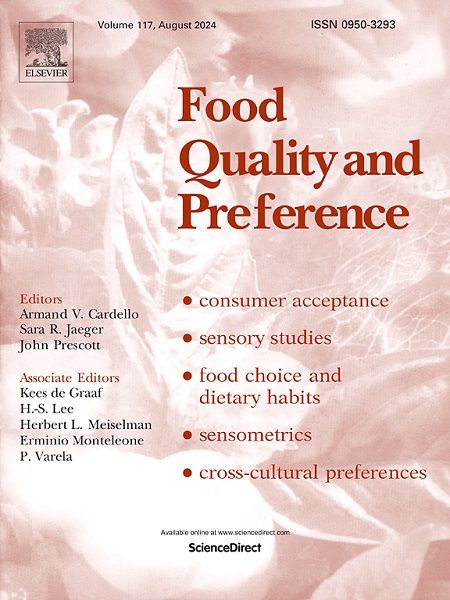支点选择和词汇利用对食品减臭支点曲线分析的影响:以豆浆为例
IF 4.9
1区 农林科学
Q1 FOOD SCIENCE & TECHNOLOGY
引用次数: 0
摘要
许多食品(特别是食品配料)中存在的难闻气味阻碍了它们的开发和生产,乳酸菌发酵的应用可能有助于减轻这些难闻的气味。作为一种快速的基于支点的描述性分析方法,支点轮廓(PP)已显示出评估食品减少异味的希望。本研究旨在通过以发酵豆浆为样本操纵枢轴来确定分析感官异味减少样本的最佳枢轴,研究使用未经训练的面板(UP)使用词汇对PP结果的影响,并使用PP方法将其与半训练面板(SP)的性能进行比较。该研究涉及三轮PP,每轮PP由两个独立的PP组成,分别以未发酵豆浆和组内发酵豆浆作为支点。UP进行了一轮关于自由描述的PP讨论,随后是关于创建描述符词典的讨论,然后是另一轮PP讨论。随后,SP(训练12 h)进行了一轮PP。结果表明,SP-PP在描述样本方面与训练小组(TP,训练33 h)进行的描述性分析(DA)最为相似。在UP进行的PP实验中,与有词典的PP相比,有自由描述的PP结果更接近TP-DA。总体结果表明,使用集内样本作为支点更适合评估异味减少样本,使用词典训练的SP进行PP可能会导致更精确的结果。本文章由计算机程序翻译,如有差异,请以英文原文为准。
Impact of pivot selection and lexicon utilization on pivot profile analysis of food off-odor reduction: The case of soymilk
The presence of unpleasant odors in many foods (especially food ingredients) impedes their development and production, and the application of lactic acid bacteria fermentation may help alleviate these undesirable odors. As a rapid pivot-based descriptive analysis methodology, the Pivot Profile (PP) has shown promise for evaluating foods with reduced off-odor. This study aimed to identify the optimal pivot for analyzing sensory off-odor reduction samples by manipulating a pivot using fermented soymilk as a sample, examining the impact of utilizing a lexicon on PP results with an untrained panel (UP), and comparing its performance with that of a semi-trained panel (SP) using the PP methodology. The study involved three rounds of PP, each round PP comprising two independent PP, with unfermented soymilk and a within-set fermented soymilk serving as pivots, respectively. The UP conducted a PP round with free descriptions, followed by a discussion on creating a descriptor lexicon and then another PP round. Subsequently, the SP (12 h of training) conducted a round of PP. The results showed that SP-PP was most similar to the descriptive analysis (DA) conducted by the trained panel (TP, 33 h of training) in describing the samples. In the PP conducted by UP, the results of PP with free descriptions were more similar to that of TP-DA compared to PP with a lexicon. Overall results suggest using a within-set sample as a pivot is more appropriate for evaluating off-odor reduction samples, and conducting PP with lexicon-trained SP may lead to more precise results.
求助全文
通过发布文献求助,成功后即可免费获取论文全文。
去求助
来源期刊

Food Quality and Preference
工程技术-食品科技
CiteScore
10.40
自引率
15.10%
发文量
263
审稿时长
38 days
期刊介绍:
Food Quality and Preference is a journal devoted to sensory, consumer and behavioural research in food and non-food products. It publishes original research, critical reviews, and short communications in sensory and consumer science, and sensometrics. In addition, the journal publishes special invited issues on important timely topics and from relevant conferences. These are aimed at bridging the gap between research and application, bringing together authors and readers in consumer and market research, sensory science, sensometrics and sensory evaluation, nutrition and food choice, as well as food research, product development and sensory quality assurance. Submissions to Food Quality and Preference are limited to papers that include some form of human measurement; papers that are limited to physical/chemical measures or the routine application of sensory, consumer or econometric analysis will not be considered unless they specifically make a novel scientific contribution in line with the journal''s coverage as outlined below.
 求助内容:
求助内容: 应助结果提醒方式:
应助结果提醒方式:


